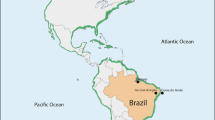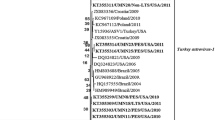Abstract
Astroviruses are becoming a growing concern in veterinary and public health. Many astrovirus species are associated with enteric diseases have been described in both mammalian and avian hosts. In the present study, 23 fecal samples from diarrheic minks were collected in Liaoning and Shandong Province, and an investigation of astrovirus was performed using biochemical methods and RT-PCR assay with specific primers. A total of four mink astroviral isolates were detected from sick minks with diarrhea problems. Further sequencing and characterization of the partial ORF1b gene and ORF2 gene segments revealed low sequence identities (20.0–85.3 and 31.8–87.2 %) with known astroviral strains, indicating the emergence of a novel clade of astroviruses. Some new features of the astroviral genome have also been discovered. The phylogenetic tree revealed that all samples were distantly related to mink astrovirus and were closely related to chicken astroviruses and turkey astroviruses. MK/DL-1, MK/DL-2, MK/SD-1, and MK/SD-2 formed a new clade and were found to be more closely related to astroviruses from birds than to other mink strains, indicating past cross-species transmission and considerable zoonotic potential.


Similar content being viewed by others
References
Appleton, H., & Higgins, P. G. (1975). Letter: viruses and gastroenteritis in infants. Lancet, 1, 1297.
Babkin, I. V., Tikunov, A. Y., Zhirakovskaia, E. V., Netesov, S. V., & Tikunova, N. V. (2012). High evolutionary rate of human astrovirus. Infection, Genetics and Evolution, 12, 435–442.
Blomstrom, A. L., Widen, F., Hammer, A. S., Belak, S., & Berg, M. (2010). Detection of a novel astrovirus in brain tissue of mink suffering from shaking mink syndrome by use of viral metagenomics. Journal of Clinical Microbiology, 48, 4392–4396.
Chu, D. K., Chin, A. W., Smith, G. J., Chan, K. H., Guan, Y., Peiris, J. S., et al. (2010). Detection of novel astroviruses in urban brown rats and previously known astroviruses in humans. Journal of General Virology, 91, 2457–2462.
De Benedictis, P., Schultz-Cherry, S., Burnham, A., & Cattoli, G. (2011). Astrovirus infections in humans and animals—molecular biology, genetic diversity, and interspecies transmissions. Infection, Genetics and Evolution, 11, 1529–1544.
Englund, L., Chriel, M., Dietz, H. H., & Hedlund, K. O. (2002). Astrovirus epidemiologically linked to pre-weaning diarrhoea in mink. Veterinary Microbiology, 85, 1–11.
Geyer, A., Steele, A. D., Peenze, I., & Lecatsas, G. (1994). Astrovirus-like particles, adenoviruses and rotaviruses associated with diarrhoea in piglets. Journal of the South African Veterinary Association, 65, 164–166.
Guo, M., Evermann, J. F., & Saif, L. J. (2001). Detection and molecular characterization of cultivable caliciviruses from clinically normal mink and enteric caliciviruses associated with diarrhea in mink. Archives of Virology, 146, 479–493.
Jiang, X., Huang, P. W., Zhong, W. M., Farkas, T., Cubitt, D. W., & Matson, D. O. (1999). Design and evaluation of a primer pair that detects both Norwalk- and Sapporo-like caliciviruses by RT-PCR. Journal of Virological Methods, 83, 145–154.
Jonassen, C. M., Jonassen, T. T., Sveen, T. M., & Grinde, B. (2003). Complete genomic sequences of astroviruses from sheep and turkey: comparison with related viruses. Virus Research, 91, 195–201.
Kang, K. I., Icard, A. H., Linnemann, E., Sellers, H. S., & Mundt, E. (2012). Determination of the full length sequence of a chicken astrovirus suggests a different replication mechanism. Virus Genes, 44, 45–50.
Kjeldsberg, E., & Hem, A. (1985). Detection of astroviruses in gut contents of nude and normal mice Brief report. Archives of Virology, 84, 135–140.
Laurin, M.A., Dastor, M., L'Homme, Y. (2011). Detection and genetic characterization of a novel pig astrovirus: relationship to other astroviruses. Archives of virology, 156, 2095–2099.
Madeley, C. R., & Cosgrove, B. P. (1975). Letter: 28 nm particles in faeces in infantile gastroenteritis. Lancet, 2, 451–452.
Martella, V., Moschidou, P., Catella, C., Larocca, V., Pinto, P., Losurdo, M., et al. (2012). Enteric disease in dogs naturally infected by a novel canine astrovirus. Journal of Clinical Microbiology, 50, 1066–1069.
Mittelholzer, C., Englund, L., Hedlund, K. O., Dietz, H. H., & Svensson, L. (2003a). Detection and sequence analysis of Danish and Swedish strains of mink astrovirus. Journal of Clinical Microbiology, 41, 5192–5194.
Mittelholzer, C., Hedlund, K. O., Englund, L., Dietz, H. H., & Svensson, L. (2003b). Molecular characterization of a novel astrovirus associated with disease in mink. Journal of General Virology, 84, 3087–3094.
Snodgrass, D. R., & Gray, E. W. (1977). Detection and transmission of 30 nm virus particles (astroviruses) in faeces of lambs with diarrhoea. Archives of Virology, 55, 287–291.
Strain, E., Kelley, L. A., Schultz-Cherry, S., Muse, S. V., & Koci, M. D. (2008). Genomic analysis of closely related astroviruses. Journal of Virology, 82, 5099–5103.
Tamura, K., Peterson, D., Peterson, N., Stecher, G., Nei, M., & Kumar, S. (2011). MEGA5: molecular evolutionary genetics analysis using maximum likelihood, evolutionary distance, and maximum parsimony methods. Molecular Biology and Evolution, 28, 2731–2739.
Zhu, A.L., Zhao, W., Yin, H., Shan, T.L., Zhu, C.X., Yang, X., Hua, X.G., Cui, L. (2011). Isolation and characterization of canine astrovirus in China. Archives of virology, 156, 1671–1675.
Acknowledgments
The author would like to thank Zhiming Zhang and all the staff of the Dalian Mingwei Mink Industry Company for providing the mink fecal samples. This work was supported by the Innovation Project Team for Special Economic Animal Disease Prevention and Control of Jilin Province (No. 20121823).
Conflict of interest
The author declares that there are no conflicts of interest with respect to the research, authorship, or in publication of this article.
Author information
Authors and Affiliations
Corresponding author
Rights and permissions
About this article
Cite this article
Sun, N., Yang, Y., Wang, GS. et al. Detection and Characterization of Avastrovirus Associated with Diarrhea Isolated from Minks in China. Food Environ Virol 6, 169–174 (2014). https://doi.org/10.1007/s12560-014-9155-3
Received:
Accepted:
Published:
Issue Date:
DOI: https://doi.org/10.1007/s12560-014-9155-3




